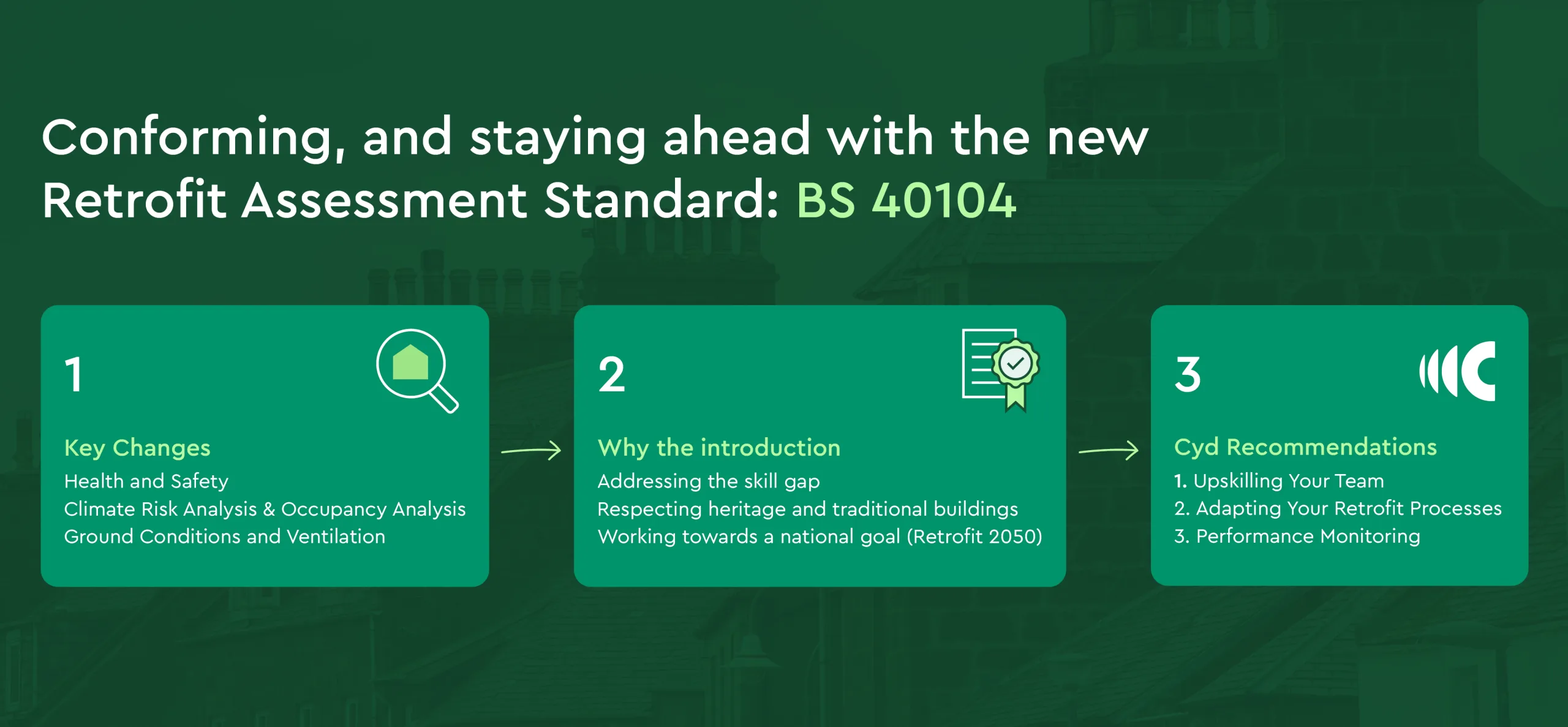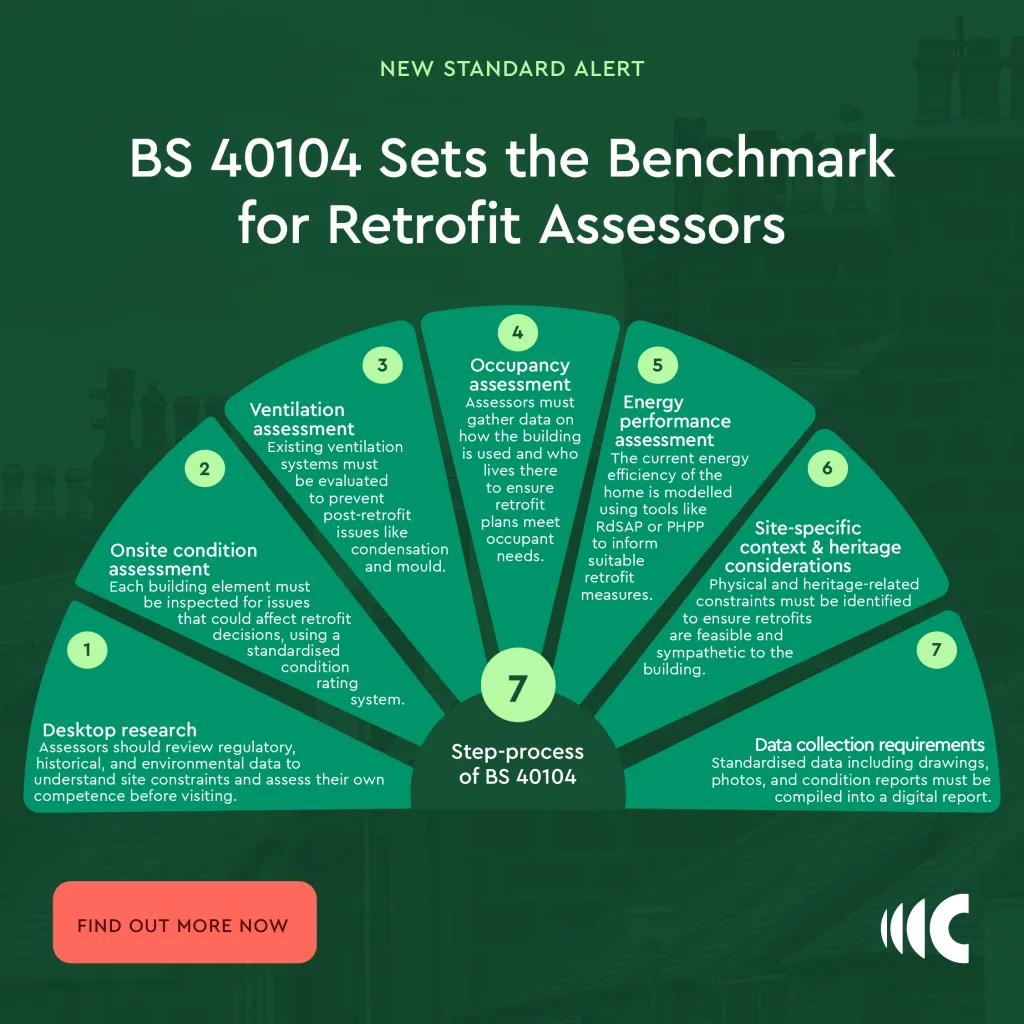
BS 40104: The New Standard Set to Transform Retrofit Assessments in the UK
As the UK accelerates its journey toward Net Zero by 2050, the wider retrofit sector faces increasing pressure from the government to deliver high-quality, sustainable home upgrades to the nation’s housing stock. 29 million homes within the U.K are still in need of retrofit service interventions. With the introduction of BS 40104, the new standard for Retrofit Assessments, hopes to mark a turning point towards retrofitting the required 29 million homes across the built environment.
The BS 40104 is due to be published on 30th September 2025, but will take time to be implemented across the built environment. BS 40104 is designed to replace key sections of PAS 2035. It provides a more robust, detailed and practical framework for retrofit assessors assessing domestic dwellings, prior to retrofit.
Not a big fan of reading? Check out our visual infographic to help you stay ahead of the BS40104 standard introduction.

Purpose and Scope of BS 40104
BS 40104 sets out a code of practice that standardises the retrofit assessment process for improved outcomes. It replaces clauses 7.3 and 7.4 of PAS 2035:2023, which previously offered limited guidance on assessment methodology. Experts in building surveying, pathology, energy efficiency, and ventilation collaborated to develop this new standard. Their work ensures that every retrofit project starts with a comprehensive, context-sensitive assessment, which helps prevent poor outcomes and performance gaps. You can find more details here.
Major BS 40104 Changes Introduced
BS 40104 places greater emphasis on Health and Safety. Specifically, occupant wellbeing. Ensuring that retrofit measures do not compromise indoor air quality, structural integrity, or thermal comfort.
The new standard integrates climate risk analysis. Requiring retrofit assessors to consider future hazards such as flooding, overheating, and moisture ingress. Typically, within the UK as adverse weather becomes increasingly prominent.
Occupancy Analysis: Assessments must now account for household behaviour and usage patterns, tailoring retrofit strategies to real-life conditions.
Ground Conditions and Ventilation: BS 40104 mandates detailed evaluations of topography, exposure, shelter, and ventilation systems. All helping to avoid common retrofit failures like condensation and damp.
Although already part of the Cyd Innovation process, the BS 40104 introduces the standardisation of the seven-stage process of whole-house retrofit:

Aligning with BS 7913
One of the most significant updates is BS 40104’s alignment with BS 7913. Relevant for the 1 in 5 UK homes considered “traditional” or “protected”.
By embedding BS 7913 principles into the newer standard, BS 40104 ensures that retrofits on older buildings respect historical significance using only compatible materials and building-friendly techniques. And avoiding irreversible damage to long-standing heritage assets.
Improving Retrofit Assessments: Addressing Skill Gaps
Research shows that only 43% of providers currently measure building performance post-retrofit. This highlights a widespread skills gap and the genuine need to encourage an increase in Retrofit quality assurance.
In supporting a wide-spread adoption, retrofit professionals will now be encouraged to pursue the Level 3 Award in Energy Efficiency for traditional and protected buildings. The Energy Efficiency qualification meets various PAS requirements, and equips retrofit assessors with the relevant skills to work on older buildings.
Courses can be found online via Energy Trust
A Timely introduction for BS 40104
As stated, the United Kingdom’s retrofit challenge is immense. 29 million homes require upgrades within 25 years (by 2050). Currently, around 50% of homes have uninsulated walls. Poor housing also costs the NHS £1.4billion annually derived from cold-related illnesses of residents, hence BS 40104 better supports residential outcomes through a more resilient and skilled retrofit workforce.
Staying Compliant: Recommendations from Cyd Innovation
As a social enterprise committed to energy efficiency and social value, Cyd Innovation has clear standings on the introduction of BS 40104 to remain compliant and ‘ahead of the curve’ in a bid to meet a nation-wide goal by 2050.
- Upskill and enrol your Retrofit Assessors and Retrofit Coordinators in the Level 3 Award to ensure compliance with BS 40104 and BS 7913. This also encourages a highly-knowledgeable internal workforce, which can be used as a strong point of parity.
- Review and adapt current assessment processes to ensure they include relevant resilience measures. Climate resilience, occupancy analysis and various ventilation checks.
- Performance monitoring tools implemented post-retrofit allows appropriate evaluations to measure outcomes, refine your future strategy and report accordingly for future work. Such also provides a great strategy for possible testimonials and case studies. Great for references into future retrofit works.
Not only are the steps above recommendations, but relevant steps to stay compliant within the new framework.
"I’ve been completing retrofit assessments in one form or another for around 15 years now, and I’m really hopeful that BS 40104 will bring a more standardised approach.
Having clear guidance should help streamline the process and make sure the data we capture onsite is accurate and comparable across all accreditation schemes and software providers. You often hear people say, ‘a successful project starts with a good retrofit assessment’ and BS 40104 feels like a big step towards making that the norm!"
Lyn Partington
Cyd Innovation Retrofit Assessor
Looking For Support With Retrofit Assessments